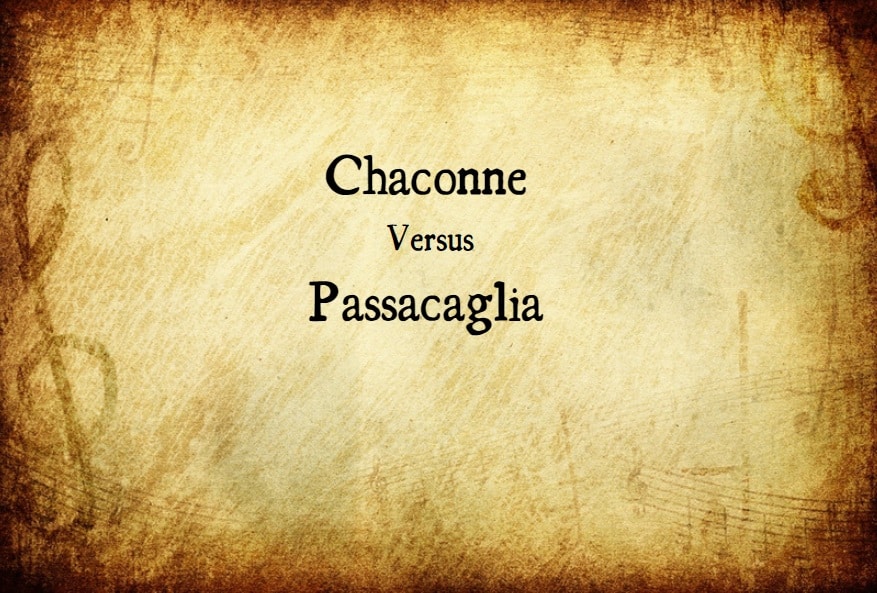
To acquire a more comprehensive understanding of these musical terms it may be useful to step back a few centuries in musical history. Like most musical phrases, words, and conventions, their origins herald back to the past. The chaconne and the passacaglia are no exceptions.
Chaconne Vs Passacaglia
The word ‘passacaglia’, derives from the Spanish ‘passacalle’ or street song. The words also and perhaps, more importantly, refer to dance too. This is thought to have come into favor in the European Courts in the 17th Century and with its heated and passionate character that was viewed by many people at the time as rather scandalous. The French Theatres of the 17th and 18th Centuries adopted the ardent Spanish passacaglia but with a more reserved sense of majesty than that of its Spanish cousin. The passacaglia would usually be a dance that had a 3/4 time-signature and had associations to male rather than female dancers.
The ‘chaconne’, is similar to the passacaglia in as much as its essence is a fiery and passionate one whose origins are also Spanish. There is some evidence to suggest its beginnings may have been as far afield as Mexico. Unlike the passacaglia, the chaconne is a dance for women, not men. Accounts of the early performances lead us to understand that the chaconne would have been performed by a pair of female dancers accompanied often by castanets. In the 17th Century courts of France, the chaconne caught on just as the passacaglia had aided in all probability by its frequent appearance in the early ballets of Jean-Baptiste Lully who was an influential figure in his day. The chaconne was also danced with a triple meter set by many composers in a major key.
Both of these early courtly dances gave rise to the passacaglia and the chaconne becoming recognized and independent musical forms. The characteristics of both dances are similar and to many ears largely indistinguishable. As a musical form, these dances became firmly established into the armory of every Baroque composer. Accurately distinguishing the passacaglia and the chaconne is a challenge and from many historical accounts, an equal dilemma for musicians of the Baroque too.
As a form of musical structure, the chaconne is a series of continuous variations composed over a repeating bass line. Sometimes the bass line is simply that, sometimes there is a series of chord progressions that compliment that given bass line. Neither the bass line or the chord pattern can change during the composition and so the composer if presented with a unique task to write music ‘above’ the existing music that is interesting enough to sustain an entire piece.
Musicians are in broad agreement today that the passacaglia is also a series of variations over a given bass and or chords but that the bass line could appear in another instrumental part or voice rather than remaining in the bass. There is a tendency to allow for the chords to undergo alteration during the music but only in line with the implied harmonies of the given bass.
To a certain extent, the chaconne and the passacaglia have a close relationship with Jazz. If you stop to consider how jazz works as a musical form, performers improvise their own melodic variations over a prescribed series of chords. They are often changed or substituted by players, but ultimately the initial pattern of chords underpins each solo until the piece returns to the original tune. I believe this is perhaps why some musicians feel strongly that JS Bach would have enjoyed the Jazz genre had he been alive to experience it.
There are countless fine examples of the chaconne and the passacaglia in the Baroque period and an equal number of compositions that span musical history up until the present day. One of my favorite chaconnes is the JS Bach ‘chaconne’ from his ‘Partita in D minor’, BWV. 1004.
What singles this piece out for me is not only the fact Bach composed it for solo violin, but that its duration is close to fifteen minutes. The theme is only four bars in length but uses chordal progressions that gradually come closer together as well as rhythms whose durations shorten as the cadence arrives. When you look closely at Bach’s achievement in this chaconne, it is almost unrivaled in any other work of the period. Despite the given intense restrictions of the musical form of the chaconne, Bach spins an astonishing set of variations for the solo violin without a moment’s weakness.
Moving forward in musical time, there is the final symphony that Brahms ever composed; the imposing 4th in E minor.
I mention this work as it is not only one of the finest pieces Brahms composed, in my opinion, but an unusual example of a symphonic passacaglia. This finale is marked with a tempo indicating speed, passion, and energy. Brahms devoted considerable time to studying the works of Bach and his influence can be felt in this work. The melody of the fourth movement is the development of Bach’s chaconne from his ‘Cantata No.150’. The whole final movement derives from an eight-bar chordal progression in E minor. In essence, Brahms composes thirty variations over the chordal structure stated at the opening of the movement in addition to a coda. Its duration does not match the Bach but still stands as an impressive compositional achievement. It is a bleak conclusion to Brahms’s last symphonic offering but one that fully demonstrates Brahms’s mastery of the passacaglia.
By way of continuing to illustrate the passacaglia form through musical history, it would be a mistake not to include the ‘Passacaglia’ Op.1 (1908), by Anton von Webern.
https://www.youtube.com/watch?v=lKg9qzR6dkU&feature=youtu.be
Again, we find ourselves in an orchestral setting with this composition, which includes a sizable brass section and percussion section. Webern pays homage to the original dance form only in name. His Op.1 is not in a triple meter and Webern crafts the form into his own exquisite composition. There are twenty-three ‘variations’ that Webern groups into three sections, concluding with a coda. The original eight-bar bass line seamlessly dissolves into the orchestral texture as the piece develops, and towards the end echoes the finale of the Brahms Fourth Symphony.

Nice article and great historical points: Correct, please, your grammar and spelinggs. It is generally accepted by scholars that the chaconne remains with the continued pre-establised HARMONY while the passacaglia uses the repeating foundational/recognizable MELODY as its connecting structure. A great example, like the Brahms you used and even less boring, is the final movement of Vaughan-Williams 5th symphony.